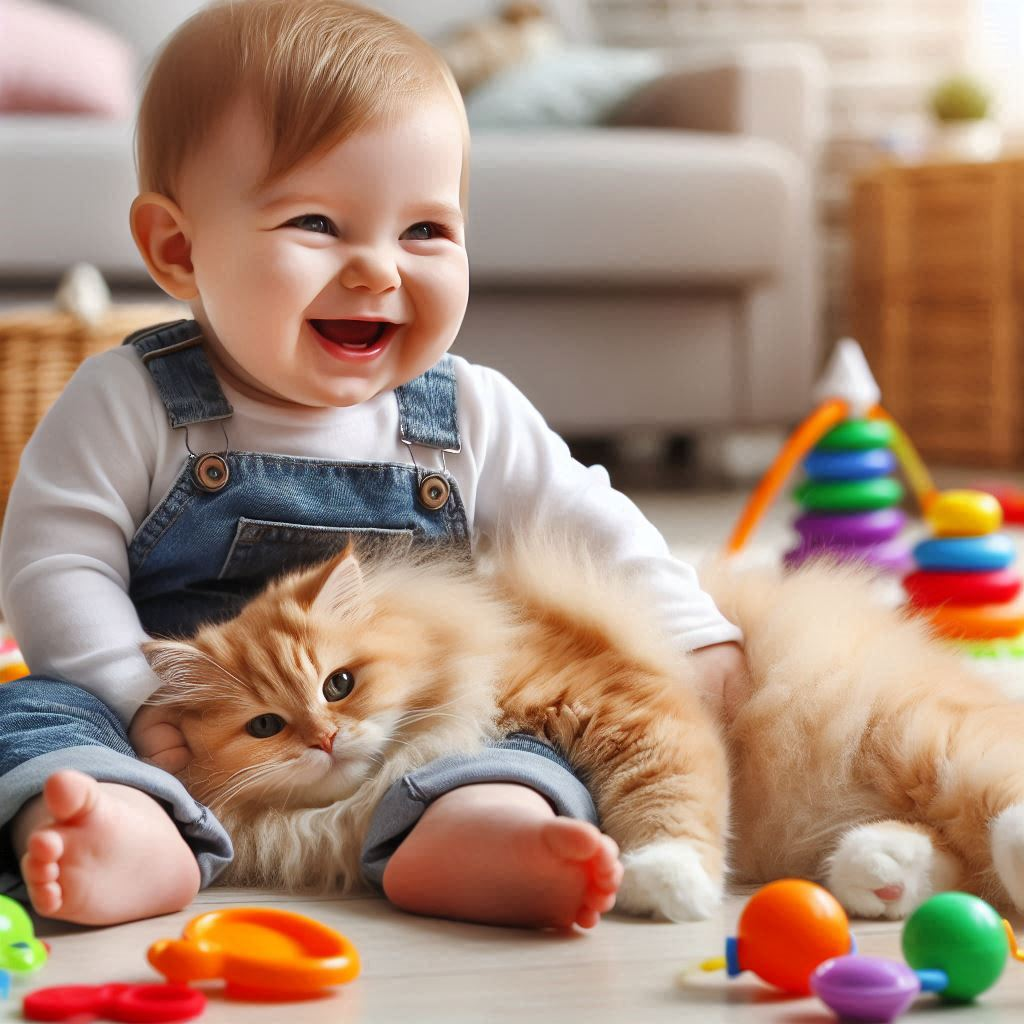Baby Playing with a Cat: Is It Safe?
As a parent, you might be wondering if it’s okay for your little one to interact with your feline friend. It’s a common question, and the answer isn’t always straightforward. Let’s dive into this topic and explore the ins and outs of babies and cats coexisting safely.
Quick Answer
Yes, babies can safely play with cats when properly supervised and with the right precautions in place. However, it’s crucial to monitor all interactions, teach gentle behavior, and create a safe environment for both the baby and the cat.
The Joys and Challenges of Babies and Cats
Picture this: your baby giggling as a fluffy tail swishes by, or your cat curiously watching as your little one learns to crawl. These moments can be incredibly heartwarming. But let’s be real – they can also be nerve-wracking for parents. After all, cats have claws and babies have grabby hands. It’s a combo that needs some careful handling.
Benefits of Baby-Cat Interactions
Before we get into the nitty-gritty of safety, let’s talk about why letting your baby and cat hang out can be a good thing:
- Emotional bonding: Pets can be a source of comfort and joy for children.
- Learning empathy: Interacting with animals helps kids develop compassion.
- Immune system boost: Some studies suggest early exposure to pets might help strengthen a child’s immune system.
- Stress relief: Even for babies, the presence of a pet can have a calming effect.
Read More Here: Where to Get a Toddler’s Hair Cut
Potential Risks to Consider
Now, let’s address the elephant (or should I say, the cat) in the room. There are some risks when it comes to babies and cats:
- Scratches and bites: Even the gentlest cat might lash out if startled or grabbed.
- Allergies: Some babies might be allergic to cat dander.
- Hygiene concerns: Cats can carry certain bacteria or parasites.
My Personal Experience: The Tale of Tommy and Whiskers
I remember when my nephew Tommy was born. We were all a bit worried about how our family cat, Whiskers, would react. Whiskers had been the “baby” of the family for years, and suddenly there was this tiny, noisy human stealing all the attention.
“The first time we brought Tommy home, Whiskers took one look at him and hightailed it under the bed. We thought, ‘Oh boy, this is going to be tough.’ But you know what? With some patience and careful introductions, those two became the best of buddies.”
It wasn’t always smooth sailing. There was that one time Tommy got a little too enthusiastic and grabbed Whiskers’ tail. Let’s just say Whiskers wasn’t too thrilled. But with some guidance and supervision, Tommy learned to be gentle, and Whiskers learned that this small human wasn’t so bad after all.
Safety First: Tips for Successful Baby-Cat Interactions
Alright, let’s get down to business. How can you make sure your baby and cat get along safely? Here are some tried-and-true tips:
1. Supervision is Key
This is the golden rule, folks. Never, ever leave your baby and cat alone together. Not even for a quick bathroom break. It’s just not worth the risk.
2. Create a Safe Space for Your Cat
Your cat needs a place to retreat when they’ve had enough baby time. This could be:
- A high perch
- A room with a baby gate
- A cozy cat tree
3. Teach Gentle Touch
As soon as your baby is old enough to interact with the cat, start teaching them how to touch gently. Show them how to pet softly, and discourage grabbing or pulling.
4. Know Your Cat’s Body Language
Cats give us plenty of signals when they’re not happy. Learn to recognize these signs:
- Tail swishing
- Ears flattened
- Low growling
- Hissing
If you see these, it’s time to give kitty a break from baby time.
5. Keep Your Cat Healthy and Happy
A content cat is less likely to lash out. Make sure your feline friend is:
- Up to date on vaccinations
- Getting regular vet check-ups
- Having their nails trimmed regularly
- Getting plenty of playtime and attention
Introducing Baby and Cat: A Step-by-Step Guide
So, you’re bringing home a new baby and you’re worried about how your cat will react? Or maybe you’re adopting a cat and you’ve got a little one at home? Either way, here’s a step-by-step guide to making those introductions go smoothly:
- Prepare in advance: Before the baby arrives, get your cat used to new smells and sounds. Play recordings of baby noises and use baby lotions or powders around the house.
- First meeting: When it’s time for the first face-to-face, keep it short and sweet. Let the cat approach the baby on their own terms.
- Positive associations: Give your cat treats and praise when they’re calm around the baby.
- Gradual increase: Slowly increase the amount of time the cat and baby spend together, always under close supervision.
- Respect boundaries: If your cat seems stressed, don’t force interactions. Give them time to adjust at their own pace.
Read More Here: What to Do with a Toddler on a Rainy Day
When to Worry: Red Flags to Watch For
While most cats and babies can learn to coexist peacefully, there are some situations where you might need to seek help:
- Aggressive behavior: If your cat consistently hisses, swats, or tries to bite the baby, it’s time to consult a vet or animal behaviorist.
- Excessive hiding: If your cat becomes overly reclusive after the baby’s arrival, they might be stressed and need help adjusting.
- Litter box issues: Changes in bathroom habits can indicate stress in cats.
- Overgrooming: If your cat starts excessively licking or chewing their fur, it could be a sign of anxiety.
The Long-Term Benefits: Growing Up with Pets
Let’s look ahead a bit. What are the benefits of kids growing up with cats?
- Responsibility: As kids get older, they can learn to help care for the cat.
- Emotional intelligence: Interacting with pets helps children understand non-verbal cues and emotions.
- Stress relief: Pets can be a great source of comfort during challenging times.
- Physical activity: Playing with a cat can encourage active play.
Frequently Asked Questions
Can cats suffocate babies?
This is an old wives’ tale. There’s no evidence that cats intentionally suffocate babies. However, it’s still important to keep cats out of your baby’s sleeping area as a general safety precaution.
What if my baby is allergic to cats?
If you suspect your baby might be allergic to your cat, consult with your pediatrician. They can perform tests to confirm the allergy and provide guidance on managing it.
How old should a baby be before interacting with a cat?
There’s no set age, but generally, once a baby can sit up on their own and has some control over their movements (usually around 6-8 months), they can start having supervised interactions with pets.
Conclusion: A Purr-fect Pair
At the end of the day, babies and cats can absolutely coexist safely and happily. It takes some effort, patience, and a whole lot of supervision, but the rewards are worth it. Just imagine the adorable photos you’ll have of your little one and their feline friend growing up together!
Remember, every child and every cat is unique. What works for one family might not work for another. Trust your instincts, stay vigilant, and don’t hesitate to seek help if you need it. With the right approach, you can foster a beautiful relationship between your baby and your cat that will last a lifetime.
Ready to start fostering a great relationship between your baby and cat? Here’s what you can do:
- Evaluate your home setup. Do you need to create any safe spaces for your cat?
- Brush up on your knowledge of cat body language.
- Schedule a vet check-up for your cat to ensure they’re healthy and up-to-date on vaccinations.
- Start introducing baby sounds and smells to your cat if you’re expecting.
- Most importantly, get ready to witness some incredibly cute moments between your little human and your feline friend!
With a little preparation and a lot of love, your home can be a happy place for babies and cats alike. Here’s to many years of purrs, giggles, and precious memories!

Jessica Winter is a passionate parenting blogger with two years of experience guiding new and seasoned parents through the joys and challenges of raising babies. Her insightful posts blend personal anecdotes with expert advice to offer a warm and practical perspective on modern parenting.

